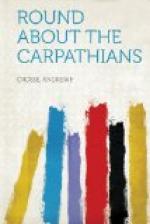Considering the expensive nature of the works, and the paucity of passengers, I almost wonder that the States Railway Company did more than construct a narrow gauge for the mineral traffic. This company, I believe, is of Austrian origin, assisted by French capital—in fact, its head office is in Paris. It obtained large concessions in the Banat during the Austrian rule in Hungary, acquiring a considerable amount of property at very much below its real value; in consequence the company is looked upon with some degree of jealousy by the Hungarians. Of forest-land alone it owns about 360 square miles. It has a large staff of officials, mostly Germans, who manage the woods and forests on a very complicated system, which pays well, but would probably pay better if simplified. It has also a monopoly of certain things in its own district, such as salt, &c.
The prevalence of bribery is one of the causes seriously retarding progress in Hungary. There is as yet no wholesome feeling against this corruption, even amongst those who ought to show an example to the community. They have also a droll way of cooking accounts down in these parts, but there is a vast deal of human nature everywhere, so “let no more be said.”
[Footnote 9: A Short Trip in Hungary and Transylvania.]
CHAPTER VI.
Mineral wealth of the Banat—Wild ride to Dognacska—Equipment for a riding tour—An afternoon nap and its consequences—Copper mines—Self-help—Bare insects—Moravicza—Rare minerals—Deutsch Bogsan—Reschitza.
The neighbourhood of Oravicza is well worth exploring, especially by those who like knocking about with a geological hammer. The mines in the Banat were perhaps worked earlier than any other in this part of Europe. The minerals of the district present a very remarkable variety. Von Cotta, I imagine, is the best authority upon the Banat ore deposits.
I had heard a good deal of the silver and copper mines of Dognacska, and wishing to visit them, I induced my friend H—— to accompany me. We arranged to go on horseback. I was very glad to escape the “carts of the country,” which, notwithstanding the atrocious roads, are the usual mode of conveyance. It had always been my intention to ride about the country, and with this view I brought my saddle and travelling apparatus from London—English-made articles bear knocking about so much better than similar things purchased on the Continent.
I had an ordinary pigskin saddle, furnished with plenty of metal rings. I had four saddle-bags in all, made of a material known as waterproof flax cloth. It has some advantages over leather, but is too apt to wear into holes. It is of importance to have the straps of your saddle-bags very strongly attached. It is not enough that they are sewn an inch into the bag, they should extend down the sides; for want of this I had to repair mine several times. Attached to my bridle I had a very convenient arrangement for picketing my horse. It consisted of a rope about twelve feet long, neatly rolled round itself; this was kept strapped on the left side of the horse’s head.




